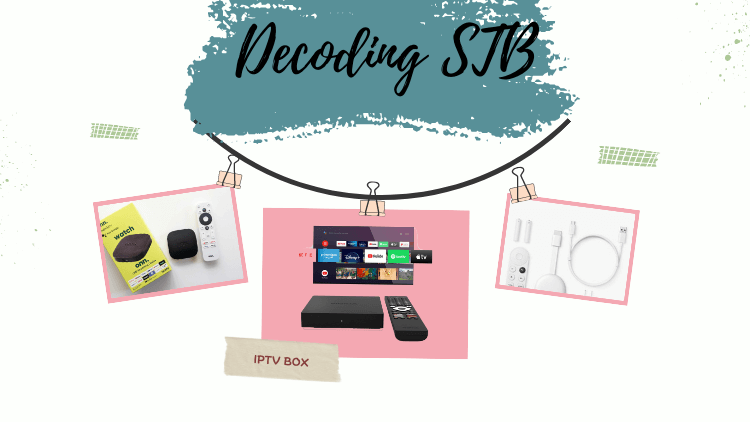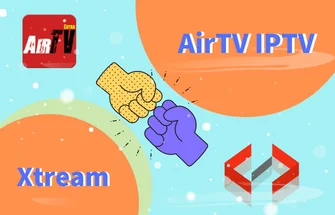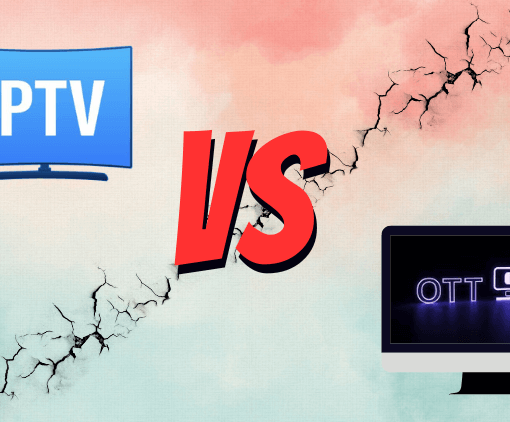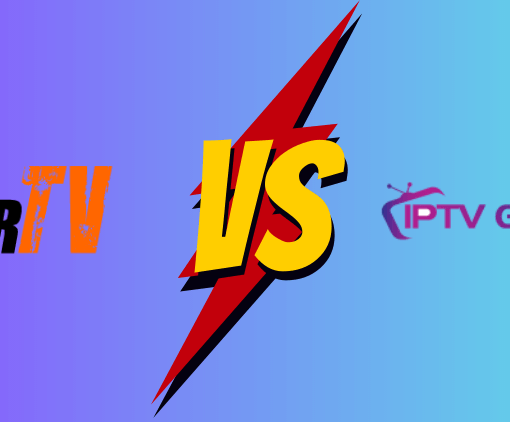Looking for the best IPTV boxes and IPTV Subscription? Look no further! In this guide, we will decode the role and features of Set Top Boxes (STBs). Whether you’re a cable TV user, satellite enthusiast, or someone who prefers internet-based television, STBs are the key to unlocking a world of entertainment options. Let’s delve into the incredible functionalities and benefits that STBs bring to your TV viewing experience.



Table of Contents
What is STB?



STB stands for Set-Top Box. It is a device that connects to a television and allows users to access a variety of content and services. STBs typically provide functionalities such as receiving and decoding digital television signals, enabling access to digital channels, interactive features, on-demand content, and internet-based services. They may also include features like recording capabilities, media playback, gaming, and streaming services. STBs are commonly used in cable, satellite, and IPTV (Internet Protocol television) systems to enhance the television viewing experience and provide additional entertainment options to users.
Related: The 10+ best IPTV boxes of 2023.
Note: A good IPTV set-top box needs to be paired with a high-quality IPTV service provider is the perfect choice. If you don’t already have a good IPTV to go with your set-top box. Then, start the IPTV service!
Features of STB
Here’s a table summarizing the features of Set-Top Boxes (STB):
| Feature | Description |
|---|---|
| Channel reception | Receives and decodes digital television signals, providing access to a wide range of digital channels. |
| Interactive features | Supports interactive services like electronic program guides (EPGs), allowing users to browse, search, and schedule recordings. |
| On-demand content | Offers access to on-demand content, allowing users to watch movies, TV shows, and other media at their convenience. |
| Internet connectivity | Provides built-in internet connectivity, enabling access to online content, streaming platforms, web browsing, and online gaming. |
| Recording capabilities | Allows users to record live TV programs and store them for later viewing using DVR (Digital Video Recorder) functionality. |
| Media playback | Supports playback of media files from external storage devices, such as USB drives or network-attached storage (NAS) devices. |
| Gaming | Provides gaming capabilities through built-in games or by supporting game downloads and streaming services. |
| Streaming services | Integrates popular streaming services like Netflix, Amazon Prime Video, Hulu, and more, offering a wide range of online content and original programming. |
| Connectivity options | Offers various connectivity options such as HDMI, Ethernet, USB, Wi-Fi, and Bluetooth for connecting to other devices and peripherals. |
| Parental controls | Includes parental control features to restrict access to specific channels, content ratings, or online services, ensuring a safer viewing environment for children. |
Please note that this table provides a general overview of the features found in STBs and may not include all the specific features of every STB model.
The advantages of using STB
Using a Set-Top Box (STB) offers several advantages for television viewers. Here are some key advantages of using an STB:
- Access to a wide range of channels: STBs provide access to numerous digital channels, including both free-to-air and subscription-based channels. Users can enjoy a diverse selection of content, including movies, sports, news, documentaries, and more.
- Improved picture and sound quality: STBs are designed to receive and decode digital signals, resulting in superior picture and sound quality compared to traditional analog TV reception. Users can experience high-definition (HD) or even ultra-high-definition (UHD) content for a more immersive viewing experience.
- Interactive features and services: Many STBs offer interactive features such as electronic program guides (EPGs), which provide detailed information about programs, schedules, and options for recording or setting reminders. Users can easily navigate through channels, access program information, and customize their viewing preferences.
- On-demand content and catch-up TV: STBs often provide access to on-demand content libraries, allowing users to watch movies, TV shows, and other media at their convenience. Additionally, some STBs offer catch-up TV services, which enable users to view recently aired programs they may have missed.
- Integration of streaming services: Many STBs integrate popular streaming services like Netflix, Amazon Prime Video, and Hulu, providing seamless access to a vast library of online content. Users can enjoy a wide range of movies, series, and original programming from various streaming platforms, all from a single device.
- DVR functionality: STBs with Digital Video Recorder (DVR) capabilities allow users to record their favorite TV programs for later viewing. They can schedule recordings, pause, rewind, and fast-forward live TV, ensuring they never miss a moment of their preferred shows.
- Internet connectivity and online services: Some STBs offer internet connectivity, enabling users to access online services, browse the web, check emails, and engage with social media platforms directly from their TV screens. They can also explore additional content, play online games, and enjoy interactive applications.
- Enhanced multimedia capabilities: STBs often support media playback from external storage devices, allowing users to enjoy their own collection of photos, videos, and music on their TV screens. This feature transforms the TV into a multimedia hub for personal entertainment.
- Parental controls and content filtering: STBs typically include parental control features, allowing parents to restrict access to certain channels, programs, or content based on ratings or specific categories. This ensures a safer and more appropriate viewing environment for children.
- Connectivity and integration with other devices: STBs offer various connectivity options, such as HDMI, USB, and Wi-Fi, enabling users to connect to other devices like sound systems, gaming consoles, or external storage devices. This integration enhances the overall entertainment experience.
These advantages make STBs a versatile and feature-rich solution for television viewers, enhancing their entertainment options, convenience, and overall viewing satisfaction.
Evolution of STB
- 1. Historical development of STBs: The Set-Top Box (STB) has undergone a remarkable evolution since its inception. Initially, STBs were introduced to improve television reception and tuning. With the transition from analog to digital broadcasting, digital STBs emerged, providing better picture quality and additional features like electronic program guides (EPG). As cable and satellite television gained popularity, dedicated STBs were developed to decode signals from these providers. Over time, STBs incorporated interactive features, enabling services like video-on-demand (VOD) and access to online applications.
- 2. Advancements in technology and their impact on STB: Technological advancements have greatly influenced the evolution of STBs. High-definition (HD) STBs were introduced to cater to the demand for higher-resolution content, delivering enhanced video quality. The integration of digital video recorders (DVRs) allowed users to record and store their favorite TV shows. The rise of internet-based television led to the development of IPTV STB, enabling the streaming of content over IP networks. Additionally, the emergence of over-the-top (OTT) streaming services brought about streaming devices that offer access to various streaming platforms. Advancements in technology continue to shape STB, with features such as 4K resolution, HDR capabilities, voice control, and artificial intelligence (AI) integration.
- 3. Integration with smart TVs and other devices: In recent years, there has been a trend towards integrating STB functionality into smart TVs and other devices. Many modern smart TVs come equipped with built-in STB capabilities, eliminating the need for a separate device. This integration offers users a streamlined and seamless TV viewing experience. STB has also been integrated with other devices like home theater systems, gaming consoles, and soundbars, allowing for a unified entertainment setup. This integration enables users to access a wide range of content and services from different sources through a single device or interface, enhancing convenience and user experience.
Overall, the evolution of STB has been shaped by historical development, advancements in technology, and integration with smart TVs and other devices. These factors have propelled STB from basic reception and decoding devices to versatile entertainment hubs, offering a multitude of features and options for users to enjoy their favorite content.
STB Challenges and Future Outlook
While Set-Top Boxes (STBs) have provided significant benefits to television viewers, they also face challenges and have a future outlook that is evolving. Here are some challenges and potential future developments for STBs:
Challenges:
- Streaming dominance: With the rise of smart TVs and streaming devices, traditional STBs face competition from platforms that offer integrated streaming services. Viewers may prefer the convenience of accessing streaming content directly from their TVs, potentially impacting the demand for STBs.
- Fragmented content landscape: The increasing number of streaming services and content providers has led to fragmentation. STBs need to adapt and provide seamless integration of various streaming platforms, ensuring a user-friendly experience for accessing content from multiple sources.
- Bandwidth and network limitations: Streaming high-quality content and interactive features require sufficient bandwidth and network infrastructure. In areas with limited internet connectivity or slower speeds, STB performance may be affected, hindering the seamless delivery of content and services.
- Evolving viewer preferences: Viewers are increasingly seeking personalized and customized content experiences. STBs need to adapt by offering advanced recommendation systems, content curation, and interactive features that cater to individual preferences and viewing habits.
Future Outlook:
- Integration with streaming services: STBs are likely to continue integrating popular streaming services to provide a unified content experience. This could involve partnerships and collaborations between STB manufacturers and streaming platforms, ensuring seamless access to a vast array of content.
- Enhanced user interfaces and interactivity: STBs are expected to improve user interfaces, making them more intuitive and user-friendly. Interactive features such as voice control, advanced search capabilities, and personalized recommendations will enhance the overall user experience.
- Integration of artificial intelligence (AI): AI technologies, such as machine learning and natural language processing, can be utilized to enhance content discovery and recommendation algorithms. This can lead to more accurate and tailored suggestions based on individual viewing preferences.
- Enhanced connectivity and IoT integration: STBs may become more integrated with other smart devices and the Internet of Things (IoT). This integration could enable seamless connectivity with home automation systems, voice assistants, and other smart devices, creating a more integrated and immersive home entertainment experience.
- Shift towards cloud-based solutions: Cloud-based STB solutions have the potential to overcome hardware limitations and offer greater scalability. This can enable more flexible and cost-effective upgrades, easier access to new features and services, and centralized management of content and settings.
- Emphasis on hybrid models: To address the challenges of content fragmentation and limited bandwidth, hybrid STB models may emerge. These models combine traditional broadcasting channels with streaming services, providing a unified experience and leveraging the strengths of both approaches.
The future of STBs lies in their ability to adapt to changing viewer preferences, integrate with streaming services, and provide seamless and personalized content experiences. By embracing technological advancements and evolving consumer demands, STBs can continue to play a significant role in delivering enhanced television viewing experiences.
Video – Definition of What is Setup Boxes(STB)
Check out our video on the definition of What is Setup Boxes. You will understand STB more thoroughly.
Related:
- How to install AirTV IPTV on Forumler Z8?
- Onn. Google TV Android Box
- How to install AirTV IPTV on NVIDIA Shield TV?
- How to use AirTV IPTV on an Android device?
- How to Install AirTV IPTV on Mi Box S?
- How to Setup IPTV on Zgemma – Primary Guide 2023
- Onn. Google TV Android Box Review
- IPTV VS OTT: Streaming Technologies Compared.
- IPTV Github: M3U Playlist for Free TV Channels 2024
What are the types of STB?
There are several types of Set-Top Boxes (STBs) available, catering to different television technologies, broadcasting methods, and user preferences. Here are some common types of STBs:
- Cable STB: Cable STBs are designed to receive and decode digital cable television signals. They are typically provided by cable operators and offer access to a range of digital cable channels and interactive services.
- Satellite STB: Satellite STBs are used for receiving and decoding digital satellite television signals. They are commonly used in satellite TV systems and allow users to access satellite channels, pay-per-view services, and interactive features.
- Terrestrial STB: Terrestrial STBs, also known as DTT (Digital Terrestrial Television) STBs, receive and decode digital over-the-air television signals. They are used for accessing free-to-air digital TV channels that are broadcasted through terrestrial antennas.
- IPTV STB: IPTV (Internet Protocol television) STBs are used for accessing television services delivered over the Internet. These STBs are designed to receive and decode IP-based television signals and provide access to IPTV channels, on-demand content, and interactive services.
- Hybrid STB: Hybrid STBs combine different technologies to provide a versatile viewing experience. They often integrate traditional broadcasting methods like cable, satellite, or terrestrial with IP-based services, allowing users to access a wide range of content from various sources.
- OTT STB: Over-the-Top (OTT) STBs are used for accessing streaming services and online content directly on a television. These STBs connect to the internet and support popular streaming platforms like Netflix, Amazon Prime Video, and Hulu, offering a wide range of online content.
- Smart STB: Smart STBs, also known as Smart TV boxes or Android TV boxes, provide a smart TV-like experience on non-smart TVs. These STBs run on the Android operating system and offer access to streaming services, apps, web browsing, and other smart features.
- DVR STB: DVR (Digital Video Recorder) STBs come with built-in recording capabilities, allowing users to record and store TV programs for later viewing. These STBs often have internal storage or support external storage devices to save recorded content.
- High-Definition STB: High-Definition (HD) STBs are designed to support high-definition television signals and provide superior picture quality compared to standard-definition STBs. They enable viewers to enjoy content in HD resolution for a more immersive viewing experience.
It’s important to note that the availability of specific types of STBs may vary depending on the region, television service providers, and technological advancements in the market.
FAQ
What does the STB do?
A Set-Top Box (STB) is a device used in the television and media industry to connect to a television. It receives digital signals and converts them into a format that can be displayed on the TV screen. STBs are commonly used for cable TV, satellite TV, and internet-based streaming services.
Which STB is best?
The best set-top box (STB) depends on individual preferences and needs. Here are some popular options:
- 1. Roku: Known for its user-friendly interface and extensive channel selection. Here’s a fix for Roku not working on Firestick.
- 2. Apple TV: Integrates well with Apple devices and offers access to the App Store.
- 3. Amazon Fire TV: Offers a wide range of apps and services, and integrates with Alexa.
- 4. NVIDIA Shield TV: Powerful STB popular among gamers, support 4K HDR content.
- 5. Google Chromecast: Affordable streaming device that allows casting from other devices.
The best choice depends on your specific requirements and budget. Research features and user reviews to find the one that suits you best.
What is STB on TV?
STB on TV stands for Set-Top Box. A Set-Top Box is a device that connects to a television and allows it to receive and display digital television signals. It converts digital signals into a format that can be viewed on the TV screen. The STB acts as an intermediary between the TV and the broadcast or streaming source, enabling access to various channels and services. It is commonly used for cable TV, satellite TV, and internet-based streaming services, providing viewers with a wide range of content options.
How does STB work?
A Set-Top Box (STB) works by receiving and processing digital signals to provide access to television content. Here’s a general overview of how an STB works:
- 1. Signal Reception: The STB receives digital signals from various sources, such as cable, satellite, or internet streaming.
- 2. Signal Decoding: The received digital signals are decoded by the STB, which converts them into a format that can be understood by the television.
- 3. Content Decryption: If the content is encrypted, the STB may have a decryption mechanism to unlock the encrypted signals, allowing access to premium or subscription-based channels.
- 4. Video and Audio Processing: The STB processes the video and audio signals to ensure they are in the correct format and quality for display on the television. This includes tasks like video upscaling, deinterlacing, and audio decoding.
- 5. User Interface: The STB has a user interface that is displayed on the television screen, allowing users to navigate through channels, access interactive features, and control the STB’s settings. This is typically done using a remote control or a user interface on the TV screen.
- 6. Channel and Content Selection: Users can select different channels, video-on-demand services, or streaming platforms through the STB’s user interface. The STB sends the corresponding requests to the service provider or content source.
- 7. Display and Audio Output: The processed video and audio signals are then sent from the STB to the television, where they are displayed on the screen and played through the speakers or audio output devices connected to the TV.
- 8. Additional Features: STBs may offer additional features like recording capabilities, time-shifting (pausing or rewinding live TV), internet browsing, streaming apps, and interactive services.
It’s important to note that the specific workings of an STB can vary depending on the type of service (cable, satellite, internet) and the features supported by the STB model.
Conclusion
In conclusion, Set Top Boxes (STBs) play a pivotal role in revolutionizing the way we consume television content. With their ability to decode digital signals, provide access to a wide range of channels, and offer interactive features, STBs have become an essential part of modern entertainment setups. Whether you’re looking for on-demand content, seamless streaming integration, or the convenience of recording capabilities, STBs have got you covered. So, if you’re ready to elevate your TV viewing experience, explore the best IPTV boxes and consider an IPTV subscription today. Embrace the power of STBs and immerse yourself in a world of endless entertainment possibilities.




